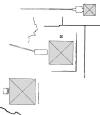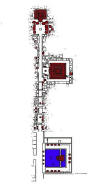|
by
Mark
& Richard Wells
from
EarthQuest Website

While searching through some satellite images of the Xian area,
we came across one that appeared to have an arrow on it, we thought
strange having an arrow on the ground. On closer inspection we
realized that we had found one of the Chinese pyramids, the
point of the arrow was really two of the corners of the pyramid and
the shaft was a roadway.
The original image has a cloud haze covering the whole area, resulting
in a very low contrast image. Even so the main pyramid is clearly
visible with a smaller pyramid just up to its left. We now used the
computer to enhance the image, allowing us to see more detail. There
now appeared to be possibly two more pyramids off to the right hand
side of the main one.
 The
next task was to see if this pyramid matched any of the ones
that had been already photographed by Hartwig Hausdorf.
At first we thought no, but we had missed out the old black and
white photo from 1947. This image seemed to match perfectly,
as you will see. The
next task was to see if this pyramid matched any of the ones
that had been already photographed by Hartwig Hausdorf.
At first we thought no, but we had missed out the old black and
white photo from 1947. This image seemed to match perfectly,
as you will see.
First the basic shape of the pyramid is the same with a flat square
top, and the sides also seem to have the same indent at their
centre. At the front there is a centre path/road leading away from
the pyramid, with two patches of trees, one on either side. The left
hand one is not squared of with the pyramid but has a slight
diagonal edge towards the centre path that can be seen in both
images. One square of trees is missing but all the other shaped
areas in front of the pyramid are correct. The objects (trees or
houses) in the rear of the pyramid can also be seen in the image.
The other nice thing about this image is, we know exactly where it was
taken. As you can see on the map ("click"
HERE)
the original large image cover an area that includes the township of
Xian yang. That puts the Pyramid where the letter 'n' is in name
Xian yang on the Map.
Back to Contents

During our ongoing research in latter part of 1998 we had been using
the Internet to search for information on ancient sites around the
world. We came across a web site that had new information about
Chinese Pyramids. The site had an article by Hartwig Hausdorf
called The Exterritorial Legacy, this article gives his own
ideas on the origin of the pyramids. The site had a number of
Photographs that were taken by the author Hartwig Hausdorf,
when he was able to gain access to a number of locations in China
that are normally of limits to visitors.
This is one of main reasons
that so little is know about them, The Pyramids are located in a
100km area around the city Xian, which is well known as the
location of the terracotta warriors. These Warriors
guard another pyramidal mound that is supposed to be tomb of
Chin, the first emperor of China. There could be up to 100
pyramids in this part of China.
As there was no survey available for this site or any of the other
Pyramid sites in China, we had no choice but to work on the small
amount of material that was available. One of the photographs shows
a number of pyramids that appear to show some
 alignment. We decided
that this photograph was worthy of closer examination. alignment. We decided
that this photograph was worthy of closer examination.
Using
computer technology we first enlarged and enhanced the photo,
then printed it out on two A3 sheets, this allowed us to work
out an approximate layout of the pyramids on the ground.
We now needed to know the cardinal directions relative to the
layout of the pyramids. As there was no information available, this
might have been a problem. The solution was in part of the enlarged
photograph. You can roughly work out the height and therefore the
position of the sun by using the length of the shadows made by the
trees (about 32 degrees). Now transferring this information and the
reference to information form the photographer's article to a Dos
version of Skyglobe on the computer, we find it is about 14.30
Hrs in the afternoon and the Sun is in the Southwest. With this
information we get an idea of the alignment of the site, with the
four central pyramids lying on the east- west axis.
Now with the sky ground ideas of Graham Hancock's in his books
"Heavens Mirror", and "Keeper Of Genesis", as well as
Robert G. Bauval Orion Giza ideas in "The Orion Mystery"
fresh in our minds. We studied a number of star maps and the
prominent star constellations. It was not hard to notice that our
plan of the pyramid layout matched the constellation of Gemini,
including the star Betelgeuse from the neighboring
constellation of Orion. Also the photograph appears as if it
has been taken from the top of another pyramid, if we add this to
the plan then you find that it matches the brightest star in Taurus,
Aldebaran.
 Now
with all this new information we used Skyglobe on the computer
to examine this area of the sky backwards through time and more
specifically to the date of 10,500 B.C.. Graham Hancock
ideas have shown that this date may have some importance in
unraveling the past. We find that the constellation of Gemini
is rising on the spring equinox on that date, with the pyramids
matching the sky, at sunrise. Now
with all this new information we used Skyglobe on the computer
to examine this area of the sky backwards through time and more
specifically to the date of 10,500 B.C.. Graham Hancock
ideas have shown that this date may have some importance in
unraveling the past. We find that the constellation of Gemini
is rising on the spring equinox on that date, with the pyramids
matching the sky, at sunrise.
This was all done with some computer technology and some technical
drawing experience, it should be treated as theory at the moment.
The only way to confirm our ideas it is to do a professional site
survey. We have posted these to get your opinion on our idea as this
may help compound the theory of Graham Hancock.
Back to Contents

With new information and photographs becoming available, we found a
second connection with the work of Graham Hancock and
Robert G. Bauval, and the Chinese Pyramids.
Perhaps you have already seen the two Photorecon pictures of
the Pyramids in China that appeared on the web, if not then
at least you are now aware of them. Having looked at the two
pictures we can see that they are not of the areas photographed by
Hartwig Hausdorf. We can only guess at their true size though we get
some impression by the agricultural field systems that can be seen
around them.
We can now take a closer look at the second one, this is a close up
from the first photo showing some of the bigger Pyramids. There are
a number of basic observations that we can make from this picture,
the first is that there are two large pyramids that stand out from
the rest. The second observation is that most of the smaller
pyramids are arranged in straight lines. The third observation that
we can make is possibly less obvious, but could be very important in
the understanding of the pyramids. The four largest pyramids create
a pattern on the ground; three of them are in a straight line with
the forth one being slightly offset.
Now if we concentrate on the two larger pyramids and the offset
pyramid we find a pattern that has been seen in the pyramids of Giza
in Egypt and Teotihuacán in Mexico (by Robert Bauval
and
Graham Handcock). Now with a basic graphics program we
can compare the four images Giza, Teotihuacán (see "Teotihuacán"),
China
and the Stars of Orion's belt.
|

China Pyramids |

Gyze Pyramids |

Teotihuacán Pyramids |

Orion |

Details of Orion |
This can be taken one step
further by overlaying all the images to form just one image, the
result as you can see is very striking...
This is the second sky ground correlation that we have found in the
pyramids of china, we can only guess at the number of other sites
that if studied in this way would show similar results. If you find
this as fascinating as we do and you won't to find out more, then
you should look at the web sites of the founders of these theories,
Robert G. Bauval and Graham Hancock.
You will need to take into account that these pictures and facts are
very rough. The Ancient Egyptians and Chinese only had
their eyes to look at the stars in the constellation of Orion,
so you can see that being precise to the arc minute and second does
not matter in this early work!. The concept of a sky ground
correlation is what we are trying to explore at the moment.
These ideas could be coincidences, but if they are not then
they could be revealing a lost knowledge of past civilizations.
Back to Contents
|







